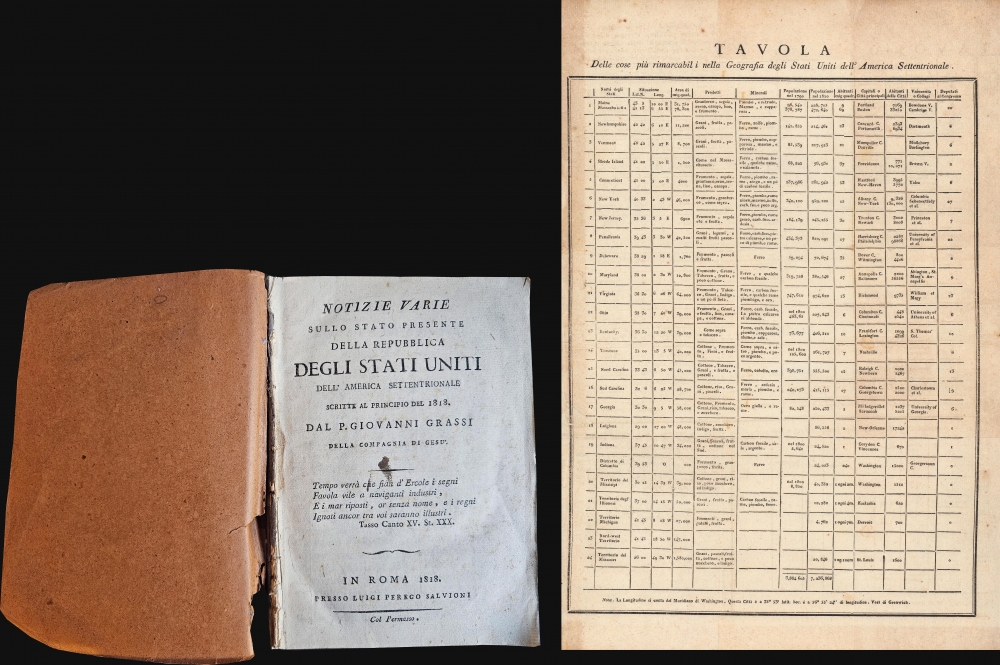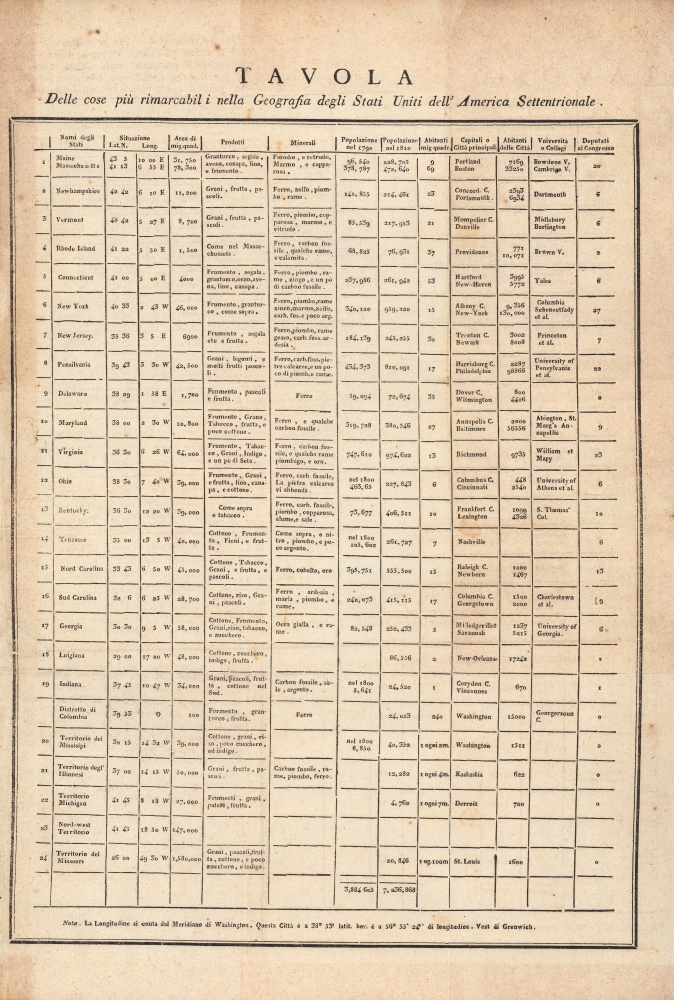1818 Grassi Informational Table on the United States of America
TavolaStatiUniti-grassi-1818
Title
1818 (undated) 16 x 10.75 in (40.64 x 27.305 cm)
Description
A Closer Look
The table provides information on the location (latitude and longitude, measured from Washington, D.C.), products, minerals, population, cities, institutions of higher education, and congressional representatives of the various U.S. states and territories. States and territories as of 1818 are listed. The reference to the North-west territory is unclear, but this was likely the northern portion of the Illinois Territory (later Wisconsin) that was transferred to the Michigan Territory when Illinois became a state in 1818. Grassi employs a combination of both standard and unconventional English spellings, with some names 'Italianized' (such as 'Luigiana').Appealing Ideas
Grassi's book likely appealed to Italians for two reasons. The first, of course, relates to Italian immigration to the United States (although the greatest waves of Italian immigration to the U.S. would not occur until the late 19th and early 20th century). The other, more pressing, reason is the United States provided an example to Italian nationalists who wanted to unite the peninsula. At the time, Italy remained a collection of duchies, kingdoms, and the Papal States. Only a few years removed from the fall of the Napoleonic Cispadane Republic, the 1820s witnessed the first push toward Italian unification after the Congress of Vienna restored the pre-Napoleonic collection of independent governments.Publication History and Census
This table appeared in Giovanni Grassi's book Notizie varie sullo stato presente della repubblica degli Stati Uniti dell'America Settentrionale, scritte al principio del 1818, published in three editions: 1818, 1819, and 1823. This table was published in the first edition as it includes the Mississippi Territory, which became a state in December 1817. It also does not include Alabama or Maine, which became states in 1819 and 1820, respectively (Maine here is coupled with Massachusetts). These facts fit perfectly with the date Grassi gives in the title as 'the beginning of 1818.' The table is not independently cataloged among the holdings of any institution and has no known history on the market, while the first edition of Grassi's book is held by nineteen libraries in North America and Europe, with a similar number holding later editions.Cartographer
Giovanni Antonio Grassi (September 10, 1775 - December 12, 1849) was an Italian Jesuit whose long sojourn in the United States included serving as the President of Georgetown College in Washington, D.C. Grassi was born in the Republic of Venice showed promise as a young student, leading to his recruitment to the Jesuit College in Polotsk (then in the Grand Duchy of Lithuania, now Belarus). He was meant to travel to China to revive the dying Jesuit mission at the Qing Court, but was unable to secure safe passage after years of effort. He then went to England and finally to the United States, where he headed the Maryland Mission of the Jesuits and served as the President of Georgetown College (later University). He is credited with overhauling the college's curriculum and administration, setting it on a path to become America's premier Catholic university. He also wrote the book Notizie varie sullo stato presente della repubblica degli Stati Uniti dell'America Settentrionale, scritte al principio del 1818, which was important for providing information on the young republic to an Italian audience (Grassi became a naturalized American citizen in 1815). During his time in the U.S., Grassi was appalled by slavery but did not endorse immediate emancipation and in his official duties oversaw slaves owned by the mission and college. Due to his success with Georgetown, Grassi was called back to Italy to lead the Pontificio Collegio Urbano de Propaganda Fide, the Holy See's institution for training missionaries. He went on to serve in various ecclesiastical and administrative roles, including as royal confessor to the king and queen of Sardinia. More by this mapmaker...












